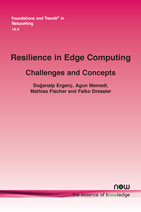Resilience in Edge Computing: Challenges and Concepts
By Doğanalp Ergenç, TU Berlin, Germany, doganalp.ergenc@tu-berlin.de | Agon Memedi, TU Berlin, Germany, agon.memedi@tu-berlin.de | Mathias Fischer, University of Hamburg, Germany, mathias.fischer@uni-hamburg.de | Falko Dressler, TU Berlin, Germany, falko.dressler@tu-berlin.de
Abstract
Edge computing has evolved significantly from early research ideas to modern 5G mobile and multi-access edge computing (MEC). In many 6G-related projects, we see a clear trend toward virtualizing computing resources at the edge. Motivated by the cloud-edge-continuum that is the basis for next-generation metaverse applications, and the need for low-latency solutions, distributed computing is now receiving even more attention. A final hurdle for the wide use of (virtualized) edge computing for mission-critical applications is resilience. In this context, resilience is the ability of modern communication and computation systems to deal with unknown and unforeseen events, both from internal and external sources. Thus, making MEC resilient to outages (e.g., system failures or energy outages due to natural disasters), security incidents (e.g., the use of intelligent jamming or malicious users), and overall challenging conditions (e.g., high mobility or impaired connectivity) is of the highest importance. In this monograph, we review the current state-of-the-art of resilience in mobile edge computing. We explore MEC-specific challenges and resilience objectives, and discuss selected resilience measures. We trust that this monograph will be an invaluable resource for beginners and experts in the field as a compound resource on resilience in MEC.
Resilience in Edge Computing: Challenges and Concepts
Computing paradigms have continuously evolved to address the growing demands of modern applications. Initially, cloud computing emerged as a transformative approach, enabling the offloading of computationally intensive tasks to centralized and virtualized infrastructures. These infrastructures provide resource scalability and flexibility, and thus can adapt to the diverse applications with varying requirements. However, the centralized nature of cloud computing resources induces additional communication delay and causes network overhead. This is especially problematic for time-sensitive and mission-critical applications. Eventually, edge computing was introduced as a complementary paradigm, bringing computational resources closer to end-users and devices. This proximity benefits time-critical applications by reducing delays and improving responsiveness. It also offers better privacy by processing sensitive data locally on devices or nearby servers, reducing the risk of exposure during transmission to centralized cloud systems. As a natural progression, multi-access edge computing (MEC) has emerged to address the unique requirements of highly dynamic environments.
In many 6G-related projects, there is a clear trend toward virtualizing computing resources at the edge. Motivated by the cloud-edge-continuum that is the basis for next-generation metaverse applications and the need for low latency solutions, distributed computing is now receiving even more attention. A final hurdle for the wide use of edge computing for mission-critical applications is resilience. In this context, resilience is the ability of modern communication and computation systems to deal with unknown and unforeseen events, both from internal and external sources. Thus, making MEC resilient to outages, security incidents, and overall challenging conditions is of the highest importance. In this monograph, the current state-of-the-art of resilience in mobile edge computing is reviewed. MEC-specific challenges and resilience objectives are explored, and selected resilience measures are discussed. This monograph is an invaluable resource for beginners and experts in the field and provides a compound resource on resilience in MEC.
